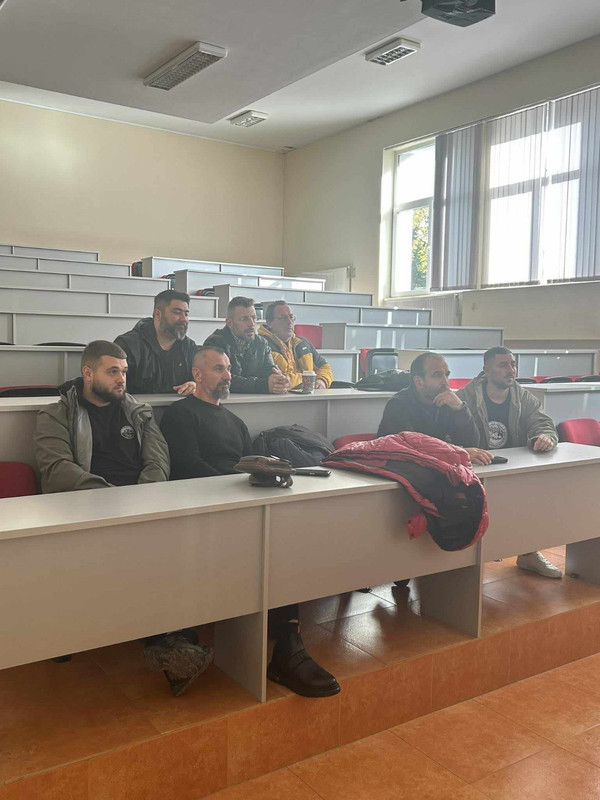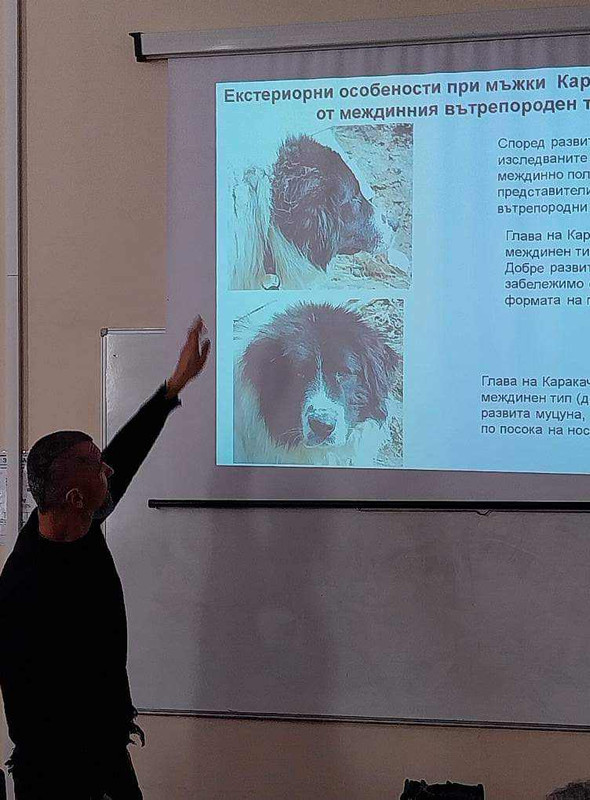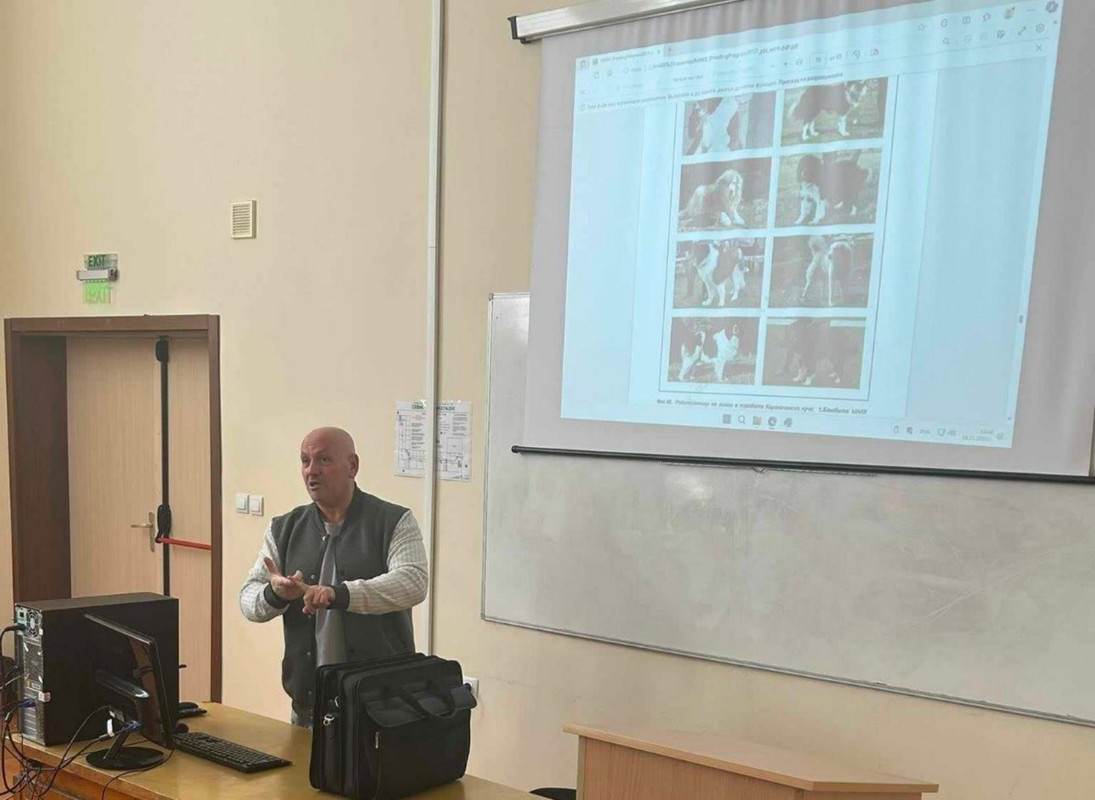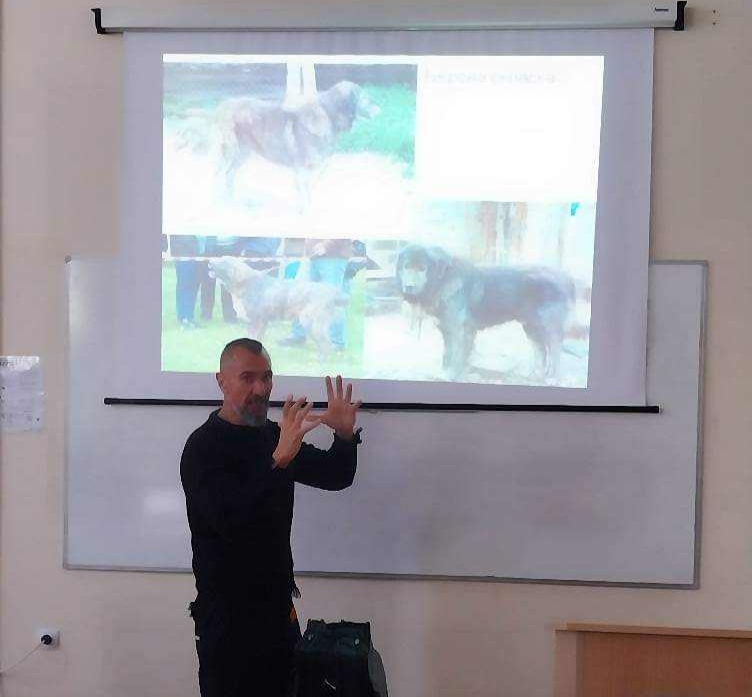




|
41
on: December 20, 2023, 19:06:34 PM
|
||
| Started by kennel Vucho - Last post by Zhelyazko_Vancheff | ||
|
Снимки от провелия се семинар с участието на зооинж. Венелин Динчев, доц. д-р. Атанас Вучков и Атила Седефчев!
    |
||
|
42
General Category / Бърборилня- (място за извънтематично общуване) / Re: Общество: размисли, чувства, позиции
on: December 20, 2023, 17:06:00 PM
|
||
| Started by Mad Max - Last post by KaraKitan | ||
|
Веселина Седларска - писател, журналист
"Не изпратих SMS на „Българската Коледа“. Не гледах и концерта. Срам ме е. Срам ме е от тази приповдигнатост, с която празнуваме липсата на държава. Срам ме е от лицемерието. Срам ме е от безочието, с което държавата подвиква да им хвърлим един sms от балкона. Не, не ни подвиква, настанява се на трапезата докато вечеряме с телевизионни клипове, затъква хапките ни в гърлото, муши се в душите ни и шепне: ти си лош, ако не пратиш sms, ето, хапваш си тук спокойно, а има деца, които чакат да бъдат излекувани, ти си лош, лош си… Лоши сме. Лоши сме, защото сме си направили държава, в която лечението на тежко болни деца не е грижа на държавата. Лоши сме, защото търпим парите да се крадат, разпиляват, да отиват за показно благосъстояние, за кич, за егоистично удовлетворение на този или онзи управник, а не за болни деца. Лоши сме, защото понасяме бездушни чиновници да решават кое дете ще живее и кое не. Лоши сме, защото години наред не можахме да принудим държавата да сложи ред във фонда за лечение на деца. За какво трябва да харчи парите си една държава, ако не за кувьози? Кувьозът е продължение на майчината утроба за деца, които се раждат преждевременно или с проблеми. Ако държавата не е купила достатъчно кувьози, това означава, че още от първия миг на това дете тя не е майка, мащеха е. От най-лошите мащехи, тези, които убиват. Лоши сме, защото не сме оказали натиск децата с тежки диагнози да получават от държавата лекарства, протези, колички, а не семействата им да фалират, за да могат децата им да виждат, чуват, прохождат, разхождат. Лоши сме, защото не изискваме от държавата да оказва подкрепа на родителите да си намират работа, съвместима с грижите за болно дете. Добри сме, докато се разминаваме по улицата с дете в количка, тикана от измъчена майка. Тогава душата ни се свива, миличкото то, горката тя, пази боже, пази боже! Но после не ни идва наум, че добрите трябва да се обединят, за да кажат на слепите: Длъжни сте да помагате от наше име на болните, затова сме ви избрали, това е общественият договор, държавата се създава, за да помага на по-слабите, на немощните, на затруднените, на подминатите от късмета да са здрави. Затова съществува държавата, а не за да направи клипче, да ровичка в душите на хората, да наеме най-модния за момента актьор, да направи концерт, да отчете, че сме добри, благородни хора, за да седнем на трапезата доволни, че сме изпълнили дълга си. Не, не сме го изпълнили." |
||
|
43
on: December 18, 2023, 09:43:14 AM
|
||
| Started by kennel Vucho - Last post by kennel Vucho | ||
|
На 18.11.2023 в Аграрен университет - Пловдив се проведе Семинар с международно участие.
На семинара присъстваха членове на Международна Асоциация Каракачанско Куче от Гърция, проявяващи интерес към автохтонната Българска порода Каракачанско куче. Темите на семинара бяха свързани с актуални аспекти при развъждането на Каракачанското куче, и мястото му като ценен генетичен ресурс за животновъдството на България, под селекционен контрол на МАКК, официално регистрирана развъдна асоциация по Закона за животновъдство на Република България. Темите бяха както следва: 1. Произход на древните кучета. Основи на генетиката при кучето като вид и приложението им при развъждане на Каракачанското куче. Лектор - Зооинженер Венелин Динчев. 2. Тълкуване на Стандарта на Каракачанското куче, разлики със сходни породи. Лектор - Доц. д-р Атанас Вучков. 3. Работни качества на чистопородното Каракачанско куче. Примери на отклонения във фенотипа и работните качества при кръстоски със други породи. Лектор - Атила Седефчев. |
||
|
44
on: December 07, 2023, 12:50:50 PM
|
||
| Started by Bojko Dobrevski sbg - Last post by Bojko Dobrevski sbg | ||
|
Уважаеми колеги , започва подготовката за календар на Асоциацията за 2024г .
Развъдниците които желаят да се включат с рекламно каре ще могат да заявят участие и да изпратят материали (снимки ,текст ,дизайн ) за своите карета . Моля да заявите участие до 20.12.2023г за да можем да сме по експедитивни със самите календари . На календара ще могат да се рекламират и партньори на МАКК (институции,фирми ,вет.кабинети и т.н.). За подробности и заявка за участие се свържете с мен Божко Добревски на тел.0894210027 Снимки и други материали за дизайна на рекламните карета изпращайте на е-майл [email protected] |
||
|
45
Forum KARAKACHAN DOG: in English / Publications, Articles, Books / Using Guardian Dogs to Protect Farm Animals /video/
on: November 29, 2023, 20:21:53 PM
|
||
| Started by KaraKitan - Last post by KaraKitan | ||
|
Using Guardian Dogs to Protect Farm Animals
https://www.youtube.com/watch?v=zGjqjKCI0MQ&ab_channel=VPM From ducks and lambs to chickens and alpacas, Virginia farmers turn to livestock guardian dogs to protect their animals and their livelihood. Jim Back talks about Maremas guarding his Alpacas prof. Phil Sponenberg talks about Karakachan dogs in his farm guarding goats and other farm animals. Note the words of prof.Sponenberg about the why is important to care about purebreeding. The answer is: predictabylity. |
||
|
46
on: November 29, 2023, 20:02:48 PM
|
||
| Started by vano - Last post by KaraKitan | ||
|
Using Guardian Dogs to Protect Farm Animals
https://www.youtube.com/watch?v=zGjqjKCI0MQ&ab_channel=VPM Във видеото чрез интервюта с двама фермери са представени две породи - Марема и Каракачанско куче. Проф.Споненбърг представя българската порода Каракачанско куче. Във видеото може да се видят неговите Каракачански кучета в неговата ферма във Вирджиния. В разговора обяснява и защо породата трябва да се съхранява в чист вид - за да имате предсказуемост в качествата на кучетата в поколенията. |
||
|
47
Forum KARAKACHAN DOG: in English / Publications, Articles, Books / The Karakachan Breed_presented by Dr.Phillip Sponenberg on Texas A&M AgriLife
on: November 29, 2023, 09:56:36 AM
|
||
| Started by KaraKitan - Last post by KaraKitan | ||
|
The Karakachan Breed
Dr. Phillip Sponenberg DVM, PhD. discusses the background and use of the Karakachan breeder of livestock guardian dogs. presentation for Texas A&M AgriLife, Livestock Guardian dog Program 17.11.2023 link: https://www.youtube.com/watch?v=GUBlDDB6qkA&ab_channel=LivestockGuardianDog-TexasA%26MAgriLife |
||
|
48
Forum KARAKACHAN DOG: in English / Breed Standard / Re: Karakachan dog Breed standard - English translation
on: November 25, 2023, 05:11:16 AM
|
||
| Started by KaraKitan - Last post by KaraKitan | ||
|
In 2017 the Breed Standard was revised.
The change is that the brindle coloration of pigmented part of a coat is no longer treated as disadvantage and is excluded from "Faults" part. ------------------------------------------------------------------------------------------------- International Karakachan Dog Association Official Breed Standard of Karakachan dog (N.B. for full version including drawings open attached PDF file) The Breed and the breed Standard are registered in 2005 in conformity with Bulgarian Law by: • Ministry of Agriculture and Foods of the Republic of Bulgaria with Resolution of State Comission for animal breeds from 10.08.2005. • Bulgarian Patent Office. Certificate for recognition of native breed № BG 10675 P2 Karakachan Dog (Karakachansko Kuche – in Bulgarian) Origin: Bulgaria Synonyms: Ovcharsko kuche, Chobansko kuche, Vlashko kuche, Thracian Mollos, Karakachan Dog, Karakatschan Hund, Chien Karakatschan, Authors of the standard: V. Dintchev, S. Sedefchev, A. Sedefchev – 14. 01. 2000 (with amendments) Date of publication of the first original valid standard: 26.06. 1991, Thracian University, Stara Zagora. Utilization: used as a watch and a guard dog for livestock, houses and a companion for people. Classification FCI: Group 2 Pinscher and Schnauzer- Molossoid breeds- Swiss Mountain and Cattle Dogs and other breeds. Section 2.2 Molossoid breeds, Mountain type. Without working trial. Brief historical survey: The Karakachan Dog is one of Europe’s oldest breeds. A typical Mollosus, created for guarding its owner’s flock and property, it does not hesitate to fight wolves or bears to defend its owner and his family in case of danger. Its ancestors started forming as early as the third millennium BC. The Karakachan Dog is a descendant of the dogs of the Thracians - the oldest inhabitants of the Balkan peninsula, renowned as stock-breeders, whom Herodotus describes as the most numerous people after the Indian one. The Proto-Bulgarians also played an essential part in the formation of the Karakachan Dog as they brought their dogs with them at the time of their migration from Pamir and Hindukush. The dog is named after the Karakachan’s - nomadic shepherds of Thracian origin. Due to their conservative stock-breeding traditions, they managed to preserve some of the oldest breeds of domestic animals in Europe – the Karakachan sheep, the Karakachan horse, and, of course, the Karakachan Dog. It is with this name that the Karakachan Dog appears in the works of some of the classics of Bulgarian literature, namely Yordan Yovkov, Georgi Raitchev and Yordan Radichkov. In 1938 H.B. Peters wrote about it in the German cynologycal magazine. The first researcher of the breed was Dr.Todor Gajtandjiev, who proposed the standardization of the breed in the 1970s. The Karakachan Dog’s bravery and dignity, together with its incredible loyalty, make this dog an invaluable friend and helper. General appearance: A massive dog. Harmoniously and proportionally built. It looks impressive and powerful. It’s powerfully muscled, with bones that are massive but not coarse. Extremely undemanding and easy to keep. Important proportions: The length of the body measures the same as the height at withers + X% - in male dogs X = 4-10% - in bitches X=6 – 15 % - the height at the elbow = 52-55% of the height at withers - the length of the muzzle = 43-45% of the length of the head Behaviour/ temperament: proud, domineering, weary to strangers, brave and intelligent dog of tough, steady and independent character. It’s got a typical deep solid bark. Head: Cranial region: The skull is broad and massive; the upper profile is slightly rounded with a shallow furrow on the forehead; the occipital bone is slightly pronounced. The supercilliary arches are only slightly developed. The axes of the muzzle and the cranial region are parallel. Stop: Visible but not emphasized. Facial region: Muzzle: Massive, widening at the base, shorter than the cranial part of the skull. Tapering very gradually from its set to the nose leather, ending flat. Nose leather: Large and well-pigmented. Wide nostrils. Lips: Thick and close-fitting. The upper lip covers the lower. Well-pigmented. Jaws (teeth): Strong jaws. 42 teeth – 20 in the upper jaw and 22 in the lower jaw. Large and white teeth, well adapted to each other. Scissor bite or pincer bite. Eyes: Small, deep and obliquely placed in the skull, with the lateral angles higher than the medial ones. Dark or hazel brown depending on the colour of the coat. The rim of the eyelid is dark pigmented. Expression is grim, confident, intelligent and firm. Ears: Rather small, low set, V-shaped, pendant, close-fitting to the skull. Neck: Short and powerful. Well-connected with the body and head. Angled at approximately 30o to the upper line. No pendant folds apart from a slight dewlap along the ventral part of the neck. Body: Upper line: Horizontal, straight. Withers: Well-pronounced, long and muscular. Back: Straight, broad and well-muscled. Loins: Of medium length, broad, well-muscled. Pronounced above the upper line. Croup: Of medium length, broad and slightly sloping. Rounded and muscular. Chest: Deep and broad but not barrel-shaped. Reaching deep at least to the points of elbow. Under line and belly: The belly is muscular, taut and slightly tucked up. Tail: Not very high set. It reaches to the hock joints but can also be short by birth. The coat on tail is long and rough. In repose it hangs low or the tip is curved(Fig.2). In movement or when the dog is alert, it is carried over the back in sabre form or curled(Fig.3). Limbs: Forequarters: Straight, parallel, massive. Shoulders and upper arm: Long and broad. Tightly joined to the body, well-muscled. Angle between shoulder blade and shoulder bone is approximately 105o. Elbow: Close-fitting to chest. Forearm: Long, with sturdy bone. Carpus: Strong and broad. Pastern: Slightly sloping. Broad and strong. Front feet: Large, round, with taut, compact toes. Arched and well-haired. Elastic dark pads. Toenails are thick and strong, preferably dark-coloured. Hindquarters: Parallel, powerful, with moderate angulation. Thigh: Of medium length, broad, well-muscled. Lower thigh: Long, broad and muscular. Hock: Broad and taut. The tibial-tarsus angle is about 140o. Hind pastern: Of medium length, massive, slightly obliquely set. Hind feet: Longer than the front feet, with taut, compact toes. Often with single or double dewclaws. Good feathering between the toes Gait/movement: Long reaching. Preferred movement is the springy trot. Skin: Thick, elastic and closely-fitting. No flabs apart from a slight dewlap along the lower (ventral) part of the neck. The nose leather and the visible mucus membranes should be black-pigmented and for red-white dogs should be brown. Coat: Quality of hair: In terms of hair length there are two types distinguished: longhaired – length of coat on the body should measure over 12 cm. shorthaired – length of coat on the body, neck and limbs measures up to 12 cm. Over the neck, withers, croup, at the back of legs, and on the tail the hair is long and rough. The topcoat is straight and stiff. Over the head and the front part of the legs the hair is short and close-fitting. Heavy undercoat. Colour of hair: Two or tricolour, with spots. Most desired are clearly defined dark spots on white or big white spots on dark. Size: Males: 63-75 cm. Bitches: 60-69 cm. Weight: Males: 40-55 kg Bitches: 30-45 kg Faults: Any departure from the foregoing points should be considered a fault and the seriousness with which the fault should be regarded should be in exact proportion to its degree. - head insufficiently massive and broad - pointed muzzle - stop insufficiently pronounced or too prominent - occipital bone too protruded - eyes protruded or round - ears set high or not close-fitting to the head - lack of pigmentation - neck long or too short - prominent dewlap on the neck - narrow or shallow chest - soft back - rounded back - tail low set - crooked legs, O-shaped or X-shaped - pasterns too sloping or straight - hock angles sharp or straight - black mask Eliminating faults: - resemblance to other breeds: Caucasian Shepherd Dog, Central Asian Shepherd Dog, Sharplaninets, Landseer, etc. - overshot - undershot, with gap between the incisors of more than 3 mm. - phlegmatic temperament - timid temperament - unreasonable aggressiveness - one-colored coat - straight tail - soft and/or curly hair - no undercoat N.B. Male dogs should have two apparently normal testicles fully descended into the scrotum. Translated by:Elica Radeva Editing of English version: D.Phillip Sponenberg,DVM,PhD |
||
|
49
on: November 17, 2023, 10:02:10 AM
|
||
| Started by Bojko Dobrevski sbg - Last post by Zhelyazko_Vancheff | ||
|
Призьорите в клас бебе-мъжки I. Кубрат Вулкан  II. Пирин Вулкан  |
||
|
50
on: November 17, 2023, 09:59:50 AM
|
||
| Started by Bojko Dobrevski sbg - Last post by skolev | ||
|
Браво на организаторите и на участниците. Когато човек работи с хъс, резултатите са налице.
 |
||